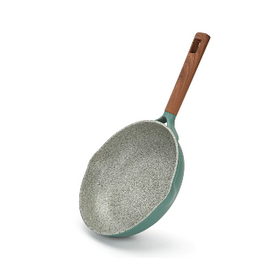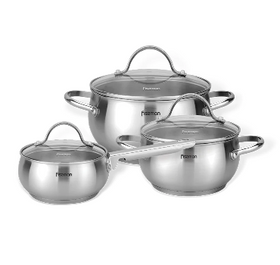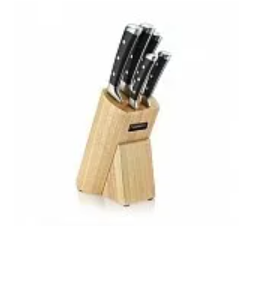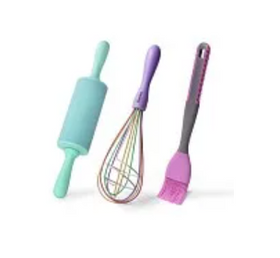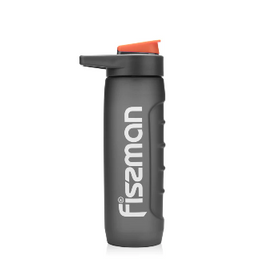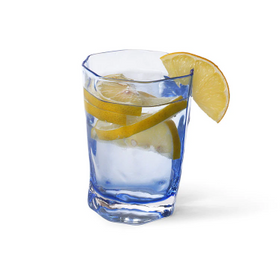Kitchenware
Filters
- Baking Dish (14)
- Baking Mat (3)
- Bowl (22)
- Brush (8)
- Brush And Spatula (2)
- Butter Dish (4)
- Can Opener (5)
- Carving Knife (6)
- Casserole (7)
- Cast Iron Frying Pan (10)
- Champagne Glass (2)
- Cheese Slicer (4)
- Chefs Knife (4)
- Cocktail Glass (3)
- Coffee Pot (5)
- Corkscrew (4)
- Crepe Pan (5)
- Crinkle (2)
- Cupcake Mold (16)
- Cutlery Set (12)
- Cutting Board (28)
- Cutting board (3)
- Deep Frying Pan (31)
- Dessert Ring (2)
- Dinner Plate (27)
- Espresso Maker (4)
- Feeding Bottle (25)
- Filleting Knife (2)
- Fish Scaler (2)
- Flask (46)
- Food Jar (3)
- French Press (11)
- Frying Pan (48)
- Glass (9)
- Glass Lid (2)
- Glass Set (8)
- Grater (18)
- Grill Pan (5)
- Honey Server (2)
- Jug (7)
- Kettle (8)
- Kettles (2)
- Kid (12)
- Kids Water Bottle (6)
- Knife (35)
- Knife Block (3)
- Knife Orgainzer (2)
- Knife Organizer (6)
- Knife Set (4)
- Knife Sharpener (10)
- Ladle (11)
- Lid (13)
- Lid Holder (2)
- Lunch Box (2)
- Mandoline Slicer (3)
- Mixing Bowl (4)
- Mixing bowl (2)
- Mug (25)
- Mug Set (6)
- Mugs Set (14)
- Nutcracker (4)
- oil and vinegar dispenser (6)
- Pairing Knife (3)
- Paring Knife (7)
- Pastry Cutter (2)
- Peeler (13)
- Pepper Mill (11)
- Pizza Cutter (2)
- Placemat (7)
- Placemats (2)
- Potato Masher (4)
- Press Coffee Maker (5)
- Rolling Pin (2)
- Santoku Knife (7)
- Santoku knife (2)
- Sauce Pan (8)
- Saucer (2)
- Serving Spoon (6)
- Shallow Pot (4)
- Slicing Knife (3)
- Spatula (18)
- Springform (5)
- Stainless Steel Stockpot (4)
- Stockpot (11)
- Storage Condiment (3)
- Strainer (8)
- Sugar Bowl (4)
- Sugar bowl (3)
- Tea Pot (4)
- Tongs (6)
- Travel Mug (3)
- Tumbler (10)
- Turner (14)
- Utility Knife (4)
- Utility knife (3)
- Water Bottle (17)
- Wine Accessories (4)
- Wine Glass (13)
- Wok (9)
- Acryl (1)
- Aluminium (53)
- Aluminium With Non-Stick Coating (9)
- Aluminum (12)
- Bamboo (6)
- Borosilicate Glass (2)
- Cast Iron (10)
- Ceramic (32)
- Corundum (5)
- Enamelled Cast Iron (6)
- German steel X50CrMoV15 (2)
- Glass (17)
- Nylon (13)
- Plastic (47)
- Porcelain (21)
- Silicone (51)
- Stainless Steel (96)
- STAINLESS STEEL (1)
- Wood (3)
- Zink Alloy (1)
- ألومنيوم (21)
- بامبو (4)
- بلاستيك (4)
- بلاستيك، سيلكون (1)
- بورسلين (1)
- حديد زهر (3)
- خشب (3)
- زجاج (22)
- ستانلس ستيل (43)
- ستانلس ستيل، بلاستيك (1)
- سيلكون (4)
- BioEcolonPro (2)
- BlueDiamond (2)
- Cast Iron (2)
- EcoStone (17)
- Enamel Cast Iron (3)
- Greblon (4)
- Greblon C3 (1)
- Greblon С2 (2)
- Greblon С3 (13)
- Greblon С3+PEEK: (1)
- Ilag Professional (2)
- IlagGranistone (3)
- Marble (7)
- Platinum (2)
- PlatinumForte (2)
- Stone (1)
- TiPro (2)
- touch stone (2)
- TouchStone (6)
- XylanPlus (7)
- ALLENDE (4)
- Anita (1)
- ARABICA (1)
- ARCADES (10)
- Aria (1)
- Azura (1)
- BIANCA (2)
- BICERIN (1)
- BLACK COSMIC (1)
- BRILLIANT (1)
- CAPELLA (2)
- CELINE (11)
- CHEFs TOOLS (1)
- CIEL (6)
- Cosmic (1)
- CREMA NOVA (3)
- DAKJJIM (3)
- DIAMOND (10)
- ELEGANCE (6)
- FIORE (7)
- Fiore (1)
- FIRENZE (5)
- FLAVIA (7)
- GRANDE (1)
- IRIS (5)
- KRONUNG (2)
- LILOU (2)
- LORZE (1)
- Luminica (7)
- LUMINOSA (1)
- LYON (8)
- MAGIC BROWN (8)
- Magic Brown (1)
- MALACHITE (4)
- Malachite (3)
- Melani (2)
- MELITA (1)
- MILANO (5)
- MIRA (2)
- MONIQUE (1)
- MONOGAMI (1)
- No (1)
- NOWAKI (1)
- PRESTIGE (5)
- PRIME (1)
- Pristine Series (3)
- Profi (1)
- PROMO (3)
- Promo (1)
- RADIANT SERIES (1)
- REBUSTO (1)
- REINA (3)
- SEAGREEN (7)
- SMOKY STONE (1)
- Smoky Stone (1)
- SPACE STONE (3)
- TAHARA (1)
- Turin (1)
- VEGA (1)
- VELA ROCK (2)
- VERSAILLES (2)
- Zonda (1)
- ستانلس ستيل (2)
There are no products matching your search
View all products"Kitchenware" is an umbrella term for a broad range of tools and utensils used to prepare food and store it. A quick overview of the different kitchenware products will help you organize your kitchen more effectively. This will also help you choose the right tools for your cooking style.
Whether you're a professional chef or an amateur home cook, you know how important it is to have the right kind of kitchenware on hand. There's no use in whipping up a mouthwatering chocolate cake if you don't have the right frosting spatula to spread the icing across your masterpiece.
Luckily, a wide range of kitchenware is available in various shapes, sizes, materials, and functions. Depending on your cooking preferences and needs, you'll want to stock up on the following types:
Cutlery
Cutlery is the name given to a group of tools used to cut food. The main examples are knives and sharpeners. The right type of knife makes cutting tasks much easier and faster.
Food Preparation Tools
Food preparation tools are those tools that help one perform tasks other than cutting, such as stirring, mixing, and grinding. Some examples include spatulas, whisks, mixing bowls, and grinders. It's important to have the right tool on hand for every task you'll encounter in your cooking routine so that you can accomplish each step quickly and efficiently.
Kitchen Gadgets
These small appliances or devices serve specialized purposes, such as opening cans or peeling vegetables. Kitchen gadgets often save time by performing simple tasks with precision. Some gadgets may be useful depending on how you cook, while others may just take up space in your kitchen drawers.
Food Storage
Food storage: This includes containers that hold food before it is prepared or after it has been cooked.
Tabletop and Bar
For many of us, "tabletop" conjures images of our family's holiday dinners. While the food is usually what people remember, it wouldn't be a meal without the plates and dishes it's served on!
One true thing about tableware is that there are many different types. There are so many plates, glasses, mugs, and serving utensils that it can be overwhelming to know what you need.
When setting up a table for any event, you may consider the types of kitchen utensils you'll need. You probably already have plates, glasses, and flatware, but there are other types of dinnerware available. Here are a few common ones
- Dinnerware: These include any items that serve food during a meal. It includes plates, bowls, cups, flatware (silverware), serving dishes, and more.
- Serveware: Serveware includes any item that serves food at a party or special event. It includes serving trays, platters, chafing dishes, gravy boats, etc.
- Drinkware: Drinkware includes any item that serves a beverage. It includes glasses for water, wine, beer, specialty beverages, and cups and mugs.
- Barware: Barware contains the items you need to assemble cocktails or other drinks at home, like shakers, strainers, and bar tools.
- Linens: Linens are napkins, tablecloths, and placemats that create a finished look on your tablescape.
When it comes to investing in your kitchen, it's important to know what you need and which tools will be most useful for you. Here are some tips to help you determine which utensils are right for you:
- Know your cooking style. Are you a beginning cook? Do you need a broad selection of utensils that you can use in different cooking scenarios? Or do you know exactly what recipes you're going to make on any given day? This will help narrow down your options.
- Ask yourself: What am I trying to achieve with these utensils? If you're just looking for a few basic items that can get the job done, start with some basics. These can include measuring cups and spoons, a whisk, and maybe a few other cooking tools. If your goal is more complicated, consider purchasing more advanced equipment such as pasta machines and cake decorating tools.
- Decide on quality over quantity. The cheapest option isn't always the best. Think about how often you'll use the tool, how durable it needs to be and how often you’ll be cooking.
Here are some simple tips for keeping your kitchen utensils in tip-top shape:
- Wash your hands before and after using the utensil.
- Avoid putting wooden utensils in the dishwasher—they will break down faster! Instead, hand wash with warm water and mild soap, then dry thoroughly before storing.
- If possible, store knives separately from other utensils (like spoons or tongs). This will preserve their edges for longer periods without dulling them prematurely by coming into contact with hard surfaces like stainless steel pans or granite counter
Biggest selection of kitchenware in the UAE. Wide range in Catalogue. Free Shipping. Easy Returns. Low prices, high quality. Shop Now.
